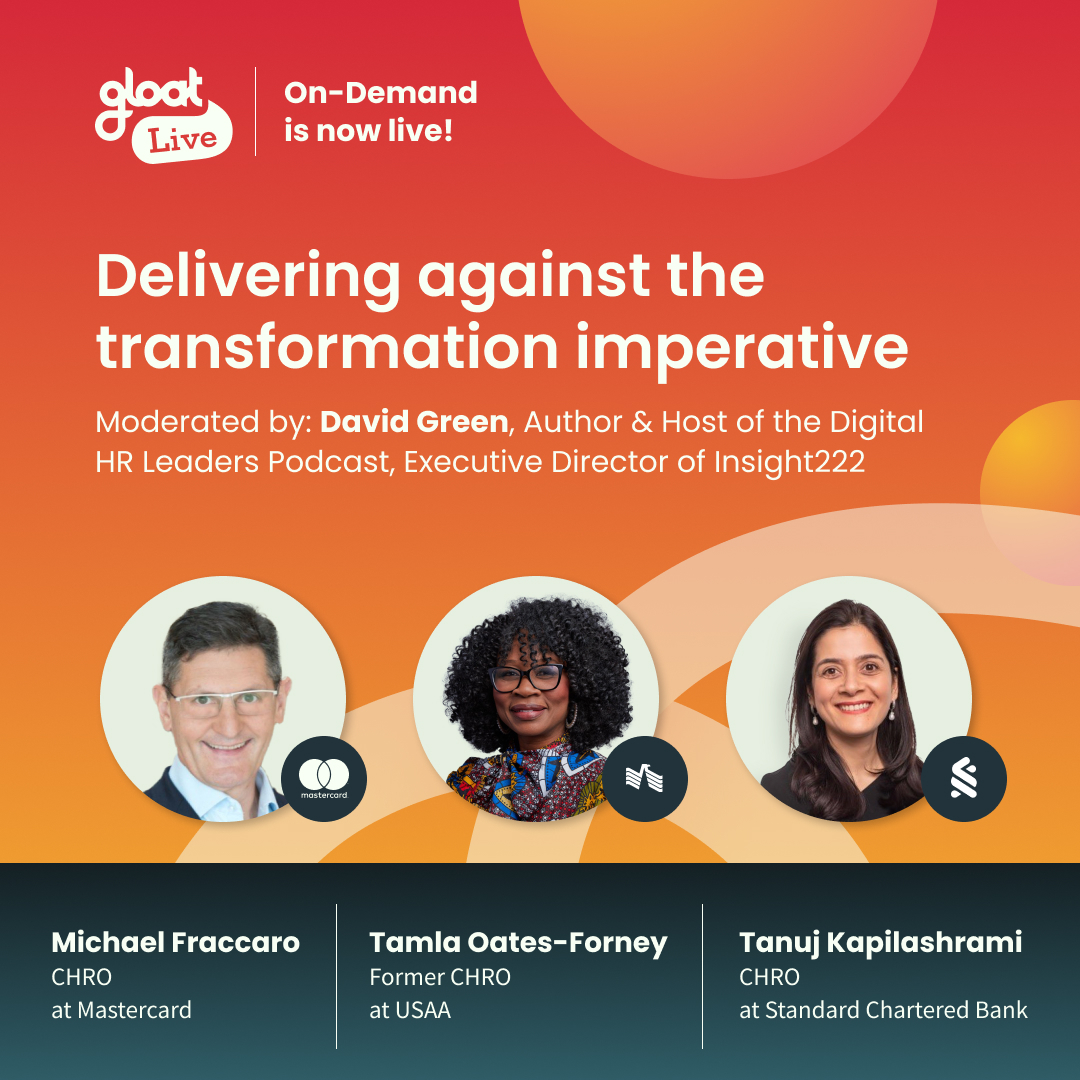What 3 CHROs have to say about skills and the future of work
What the future of skill-building looks like, according to the executives who are shaping it There’s a lot of uncertainty about our new world of work—but most leaders are resolute that change must be on the agenda. Nearly 1 in 2 CEOs don’t think their companies will be viable in 10 years if they remain on their

What the future of skill-building looks like, according to the executives who are shaping it
There’s a lot of uncertainty about our new world of work—but most leaders are resolute that change must be on the agenda. Nearly 1 in 2 CEOs don’t think their companies will be viable in 10 years if they remain on their current path.
Many of these leaders are looking to their counterparts in HR for a solution. CHROs are now at the helm of architecting new ways of working that meet employees’ expectations for greater autonomy while helping the business cut costs and maximize efficiency.
None of these priorities are simple tasks, which is why many HR leaders currently find themselves stuck at a challenging crossroads. Fortunately, we caught up with three visionary CHROs during Gloat Live to learn why they believe skills will be at the heart of every successful enterprise-wide transformation.
Inside the evolving role of the CHRO
While HR was once a primarily administrative function, modern CHROs are stepping into a role that’s decidedly strategic. HR functions are now responsible for helping their organizations navigate change and devise innovative solutions for talent and resourcing challenges.
Many CHROs have two central priorities that may occasionally seem at odds with one another: reimagining work to give employees greater autonomy and improving cost efficiency. At times, it might seem like HR is in the midst of a challenging balancing act, with employee expectations on one side and the needs of the business on the other.
To carve a path forward that addresses both of these priorities, HR leaders increasingly rely on analytics and insights, with 85% of CHROs noting that data is a key part of their strategy. Insights into the skills their people have and the knowledge their organizations must hone will be particularly crucial for driving successful transformations that minimize costs to the business while maximizing employee satisfaction.
Why skills deserve a spot at the top of CHRO’s agendas
Skills-based strategies have the potential to create a “best of both worlds” solution for CHROs looking to meet employee expectations and business needs. Breaking down work into a skills-based approach enables HR leaders to develop an in-depth understanding of the capabilities their people have and those they need.
With the help of AI-powered skills intelligence tools, CHROs can identify employees who can be upskilled or reskilled to step into high-priority roles as well as pinpointing skill adjacencies and transferable skills. Armed with these insights, HR can empower employees to hone the capabilities they’ll need to step into their desired careers while simultaneously keeping costs low by sidestepping many expenses associated with external hiring, recruitment, and contractor spend. Breaking work down at the skill level means that employees are no longer confined to what they were hired to do; instead, they can put their skills to use across the entire organization so that the business can work smarter, not harder.
5 skills insights from visionary HR leaders
Forward-thinking CHROs are embracing skills strategies head-on—just ask Michael Fraccaro, Tanuj Kapilashrami, and Tamla Oates-Forney, who spoke on our CHRO panel at Gloat Live. The current and former HR leaders at Mastercard, Standard Chartered Bank, and USAA have a few words of wisdom for CHROs who are looking to level up their transformations with a skills-based approach.
#1. Organizations that aren’t proactively skill-building will fall behind
The first thing that Mastercard’s Chief People Officer Michael Fraccaro wants people to know is that complacency isn’t an option when it comes to skills transformations. “If organizations aren’t thinking about transformation and not doing something to connect their business strategy with their workforce and how they think about job design and upskilling and reskilling, they’re gonna fall behind,” he warns.
If leaders want to set their businesses up for success in our ever-changing world of work, they’ve got to think about how work is broken down. CHROs must consider how they can reallocate and redeploy talent based on the skills their people possess and the capabilities their organization needs to accomplish key business priorities.
#2. The war for talent has turned into a race for hot skills
For a long time, HR leaders have heard warnings about a “war for talent”, underscoring the notion that skilled workers are becoming increasingly scarce and that employers must now fight to retain them. According to Standard Chartered Bank’s Chief Human Resources Officer Tanuj Kapilashrami, that battle has now morphed into a competition to cultivate in-demand skills within your organization.
In her words, “You can keep talking about skills, but what is the game? What is the prize? The prize is that the war for talent has actually become a war for hot skills in the world. And unless companies deconstruct their operating models, they’re gonna lose out on the war for hot skills, which is what the talent war is all about.” Much like Fraccaro, Kapilashrami emphasizes that companies must shift their ways of working and embrace skills-based talent management strategies to ensure their workforces have the capabilities they need to accomplish their strategic objectives.
#3. HR leaders must break down silos to pave the way for agile operating models
One of the key benefits associated with embracing a skills-based approach is that this strategy unlocks greater agility by removing the silos that come with traditional job hierarchies. Agility will be crucial to thriving in the new world of work, and it’s something that former USAA CHRO Tamla Oates-Forney believes HR leaders must role model within their organizations.
“When I think about dynamic, I think about being agile,” she explains. “You have to be able to change. You can’t be so stuck in your ways of working that you don’t change. And as HR professionals, sometimes we are the biggest culprits of hierarchy, bureaucracy, and lack of change. So we have to be the change that we want to see if we want to encourage our organizations to change,” she concludes.
Oates-Forney notes that breaking down silos and moving away from rigid hierarchies will be crucial for embracing the skills-based strategies that are known to usher in more dynamic ways of working. Traditional job hierarchies must be replaced by more dynamic talent management approaches in which employees lend their skills to projects and tasks across their organizations.
#4. Tap into your entire workforce to develop the skills your organization needs
In addition to saving businesses millions of dollars in reduced hiring expenses, contractor spend, and onboarding time, shifting to a skills-based approach can create better outcomes for employees, as Fraccaro explains. Referring to Mastercard’s skills-powered internal mobility initiative, he says, “This was about connecting people to these priceless career opportunities. And we said, ‘Wow, we’ve just been able to find talent with particular skills in parts of the organization that we didn’t even know about.”
What he’s describing is a true win-win for CHROs. Employees have the chance to put their skills to use by participating in opportunities that align with their interests and ambitions, while managers gain access to in-demand capabilities by cultivating new cross-functional partnerships with employees on different teams and within different departments.
#5. Don’t underestimate the power of skills adjacencies
Kapilashrami also emphasizes how skills-based approaches benefit both employers and employees. In describing her organization’s skills-based transformation, she discusses an important turning point, noting, “This year, we’ve become quite prescriptive. We’ve said for certain types of jobs, we will not hire externally because we’ve got skills adjacencies within our business that we can reskill and redeploy. So good for our business, but also massively great for our employees.”
With help from skills intelligence tools like Gloat’s Skills Foundation, leaders at companies like Standard Chartered Bank can see which employees possess skills that are related to the capabilities that are in high demand. By focusing on transferable skills and skills adjacencies, companies can quickly develop the talent they need internally, cutting out the time and expenses associated with external hiring to bridge skill gaps.
To learn more about the priorities that winning HR leaders are putting at the top of their agendas, check out this conversation with three visionary CHROs.





